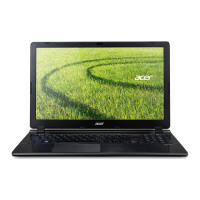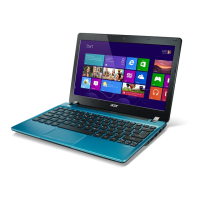
Do you have a question about the Acer Aspire V5-573 and is the answer not in the manual?
| Model | Acer Aspire V5-573 |
|---|---|
| Display Size | 15.6 inches |
| Storage | 1 TB HDD |
| Graphics | Intel HD Graphics 4400 |
| Operating System | Windows 8.1 |
| Wireless | Wi-Fi 802.11a/b/g/n, Bluetooth 4.0 |
| Processor | Intel Core i5-4200U |
| Display Resolution | 1920 x 1080 |
| RAM | 8 GB |
| Battery | 4-cell Li-ion |
| Ports | 1 x USB 3.0, 2 x USB 2.0, HDMI, Ethernet |
Covers essential safety instructions, warnings, and electrical power precautions for safe operation.
Guidelines for safe battery usage, including temperature limits and charging advice.
Tips for comfortable computer use to prevent eyestrain, headaches, and musculoskeletal issues.
Introduces the setup guide, quick guide, and user's manual for new computer users.
Provides essential tips for maintaining the computer, including care for the AC adapter and cleaning.
Identifies and describes the webcam, touchscreen, and microphones on the laptop screen.
Details the keyboard layout, power/battery indicators, and touchpad functions.
Illustrates and describes the ports located on the left side of the notebook.
Explains the function of lock keys (Caps Lock, Num Lock, Scroll Lock) and hotkeys for system controls.
Details the functions of the Windows key and application key for system navigation and shortcuts.
Explains basic touchpad operation, gestures like sliding, tapping, and right-clicking.
Describes advanced touchpad gestures for navigation, such as swiping and pinching.
Guides on creating factory default and drivers/applications backups for system recovery.
Provides methods for recovering the system, including reinstalling drivers and applications.
Details options for returning the system to a previous state or factory condition.
Instructions on how to disable the fast startup feature to conserve battery power.
Information on charging the battery, conditioning new packs, and general usage advice.
Tips to optimize battery operation and prolong its lifespan, including storage and usage patterns.
Steps for disconnecting accessories and preparing the computer for short-distance moves.
Guidelines for traveling with the computer, including carry-on luggage and airport security.
Advice for traveling internationally, including power compatibility and customs.
Instructions on using a Kensington-compatible security slot to physically secure the computer.
Details on setting Supervisor and User passwords for BIOS and system access.
Explains how to start and set up Acer Theft Shield for theft prevention using phone or Wi-Fi.
Covers alarm settings, notifications, and configuring Wi-Fi hotspot network for the Theft Shield.
Basic steps for connecting to the internet via wireless networks and using Acer Instant Connect.
Details the components needed for setting up a wireless network, including access points/routers.
Instructions on enabling/disabling the Bluetooth adapter and pairing devices.
Step-by-step guide for pairing new Bluetooth devices with the computer.
Explains the Acer Converter Port's purpose and its support for LAN, display, and USB connections.
Describes the HDMI interface for high-definition audio/video connections to external equipment.
Explains the function of USB ports for connecting peripherals without consuming system resources.
How to set the boot sequence in the BIOS utility for managing boot devices.
Instructions on setting Supervisor and User passwords within the BIOS utility for security.
Addresses common problems like power issues, blank screens, no audio, and keyboard response.
Guides on how to request service and details about the International Travelers Warranty (ITW).
Explains key Windows 8 concepts like Start, Tiles, and Charms for new users.
Provides guidance on accessing charms, switching apps, and unlocking the computer.
Instructions on personalizing the Start screen, lock screen, and managing app tiles.
General advice for diagnosing and resolving system problems using onscreen error messages.
Lists common error messages and their corresponding corrective actions.
Details FCC statement, shielded cables, peripheral device requirements, and radio device notices.
Covers EU declaration, wireless channels, French frequency restrictions, and national operating codes.











